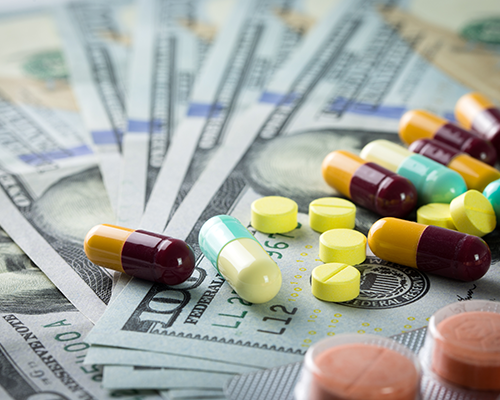As we look forward into 2022, what legislative and regulatory changes could be in store? Currently, the most obvious piece of legislation with drug pricing implications is the Build Back Better Act (BBBA). President Biden’s BBBA was passed by the House of Representatives on November 19, with the Senate intending to vote on its version, through reconciliation, before Christmas. The BBBA includes several provisions that may lower prescription drug costs for people with Medicare and private insurance while also reducing drug spending by the federal government and private payers. The Congressional Budget Office (CBO) has estimated that these pricing provisions could reduce the federal deficit by $297 billion over 10 years (2022-2031).
One of the key prescription drug proposals in the BBBA is the ability of the federal government to negotiate prices for some high-cost drugs covered under Medicare Part B and Part D. The law that established the Part D benefit includes a provision known as the “noninterference” clause, which stipulates that the Department of Health and Human Services (HHS) Secretary “may not interfere with the negotiations between drug manufacturers and pharmacies and prescription drug plan (PDP) sponsors…” Under current law, the Secretary of HHS also does not negotiate prices for drugs administered by physicians which are covered under Part B.
The BBBA would amend the noninterference clause by adding an exception allowing the federal government to negotiate prices with drug companies for a small number of high-cost drugs covered under Part D (beginning in 2025) and Part B (beginning in 2027). Negotiations would be limited to no more that 10 drugs in 2025, 15 drugs in 2026 and 2027, and 20 in 2028 and beyond. This will apply to single-source, brand-name drugs or biologics that lack generic or biosimilar competitors that are among the 50 drugs with highest total spending under Medicare Part D and Part B. The negotiations will also apply to all insulin products and are separate from the maximum number of new drugs negotiated annually.
It is important to note that the number of drugs that the Secretary of HHS can negotiate is cumulative. Specifically, price negotiations for 2025 will begin in February 2023 and are limited to 10 drugs; by 2026, an additional 15 drugs will be added, making the total 25. By 2027, another 15 drugs plus the previous 25 puts the total at 40. By 2028, the total could be as many as 60 drugs. And as noted previously, this does not include negotiated insulin products. This means that there is no limit on the number of drugs that can be negotiated over time. However, the negotiated prices are locked in and can only increase at the rate of inflation until a generic competitor or biosimilar enters the market.
There are further limits on which drugs are eligible for negotiation that may affect the impact the provision will have. Only small molecule drugs that have been on the market for 9 years and biologics that have been on the market for 13 years (originally 12 years) are eligible. Drugs that treat very rare conditions and drugs that cost the program $200 million or less annually are also exempt.
The proposal establishes parameters for the negotiated price. The upper limit, or “maximum fair price,” is equal to a percentage of the non-federal average manufacturer price: 75% for small-molecule drugs more than 9 years but less than 12 years beyond approval; 65% for drugs, including biologics, between 12 and 16 years beyond approval or licensure; and 40% for drugs more than 16 years beyond approval. Part D drugs with prices negotiated under this proposal, including insulin, would be required to be covered by all Part D plans. Payment for Part B medications to providers would be 106% of the maximum fair price instead of the average sale price (ASP) currently in use. Furthermore, payments for biosimilar products would be increased to 108% between April 1, 2022, through March 31, 2027.
Key takeaways:
- There may be unintended consequences on competition and uptake of generic and biosimilar drugs if the prices of highly utilized single-source drugs are artificially controlled
- Price controls that do not take into account the clinical value or cost effectiveness of individual products may influence physician choice to use less effective products which have more lucrative reimbursement rates
- Pharmacy benefit managers (PBMs) will pivot their formulary and utilization management strategies in order to recoup the diminished rebate revenue from all manufacturers, particularly those products that are exempt from Centers for Medicare & Medicaid Services (CMS) negotiations
References
- Cubanski J, Neuman T, Freed M. Explaining the prescription drug provisions in the Build Back Better Act. Kaiser Family Foundation. Published November 23, 2021. https://www.kff.org/medicare/issue-brief/explaining-the-prescription-drug-provisions-in-the-build-back-better-act/
- Owens C. A surprising opponent of Democrats’ drug pricing plan: generics. Axios. Published December 8, 2021. https://www.axios.com/surprising-opponent-of-democrats-drug-pricing-plan-5bc65664-2e4f-4462-b3b3-325ddbc83af0.html?utm_source=newsletter&utm_medium=email&utm_campaign=newsletter_axiosvitals&stream=top
- Owens C, Herman B. Medicare drug negotiations may not be as limited as we thought. Axios. Published November 5, 2021. https://www.axios.com/democrats-medicare-prescription-drug-negotiations-bf94bd22-3aad-42c1-a9f1-12c9183814c0.html


